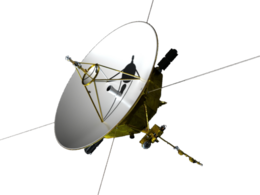 Artist's rendering of the Interstellar Probe (plasma wave antennas extend far beyond portion shown) | |
| Mission type | Outer planetary, heliosphere, and interstellar medium exploration |
|---|---|
| Operator | NASA / Johns Hopkins Applied Physics Laboratory |
| Website | interstellarprobe |
| Spacecraft properties | |
| Launch mass | 860 kg (1,900 lb) |
| Power | 470 watts (at launch) |
| Start of mission | |
| Launch date | 2036 |
| Rocket | Space Launch System Block 2 |
| Flyby of Jupiter | |
| Closest approach | 2037 |
| Distance | ~4 000 km |
Interstellar Probe (ISP) is a proposed NASA space probe designed to explore and characterize the heliosphere and interstellar space. The study was originally proposed in 2018 by NASA for the Applied Physics Laboratory. It would have a baseline launch between 2036 and 2041.[1] The probe would launch on a direct hyperbolic trajectory to encounter Jupiter after six to seven months, after which the probe would travel at a speed of about 6–7 astronomical units (900,000,000–1.05×109 kilometres) per year, leaving the heliosphere after only 16 years.[2]
The probe may have the opportunity to encounter minor planets on the way out, including Orcus and Quaoar, though such flybys would require specific launch dates. With next-generation radioisotope thermoelectric generators (RTGs), the mission would be designed to last for over 50 years after its launch, a similar feat reached by the Voyager 1 and 2 probes despite their intended 5-year lifetime. The mission has been called "Voyager on steroids".[2]
- ^ McNutt, Ralph; Paul, Michael; Brandt, Pontus; Kinnison, Jim. "Interstellar Probe: Humanity's Journey to Interstellar Space" (PDF). Interstellar Probe. Johns Hopkins Applied Physics Laboratory. Retrieved 23 December 2021.
- ^ a b Stone, Richard (28 July 2022). "'Voyager on steroids.' Mission would probe mysterious region beyond our Solar System". Science. doi:10.1126/science.ade1070. Retrieved 15 August 2022.